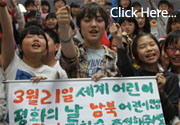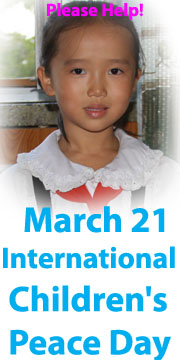|
|
|
|
India
Main Page
|
|


The People
of India
|
Population:
|
|
1,173,108,018 (July 2010 est.)
country
comparison to the world: 2 |
|
|
Age structure:
|
|
0-14 years: 30.5%
(male 187,197,389/female 165,285,592)
15-64 years: 64.3%
(male 384,131,994/female 359,795,835)
65 years and over: 5.2%
(male 28,816,115/female 31,670,841) (2010 est.)
|
|
|
Median age:
|
|
total: 25.9
years
male: 25.4
years
female: 26.6
years (2010 est.)
|
|
|
Population growth rate:
|
|
1.376% (2010 est.)
country
comparison to the world: 89 |
|
|
Birth rate:
|
|
21.34 births/1,000 population
(2010 est.)
country
comparison to the world: 85 |
|
|
Death rate:
|
|
7.53 deaths/1,000 population
(July 2010 est.)
country
comparison to the world: 115 |
|
|
Net migration rate:
|
|
-0.05 migrant(s)/1,000 population
(2010 est.)
country
comparison to the world: 123 |
|
|
Urbanization:
|
|
urban population: 29%
of total population (2008)
rate of urbanization: 2.4%
annual rate of change (2005-10 est.)
|
|
|
Sex ratio:
|
|
at birth: 1.12
male(s)/female
under 15 years: 1.13
male(s)/female
15-64 years: 1.07
male(s)/female
65 years and over: 0.91
male(s)/female
total population: 1.08
male(s)/female (2010 est.)
|
|
|
Infant mortality rate:
|
|
total: 49.13
deaths/1,000 live births
country
comparison to the world: 53
male: 47.7
deaths/1,000 live births
female: 50.73
deaths/1,000 live births (2010 est.)
|
|
|
Life expectancy at birth:
|
|
total population: 66.46
years
country
comparison to the world: 160
male: 65.46
years
female: 67.57
years (2010 est.)
|
|
|
Total fertility rate:
|
|
2.65 children born/woman (2010
est.)
country
comparison to the world: 81 |
|
|
HIV/AIDS - adult prevalence
rate:
|
|
0.3% (2007 est.)
country
comparison to the world: 89 |
|
|
HIV/AIDS - people living with
HIV/AIDS:
|
|
2.4 million (2007 est.)
country
comparison to the world: 4 |
|
|
HIV/AIDS - deaths:
|
|
310,000 (2001 est.)
country
comparison to the world: 2 |
|
|
Major infectious diseases:
|
|
degree of risk: high
food or waterborne diseases: bacterial
diarrhea, hepatitis A and E, and typhoid fever
vectorborne diseases: chikungunya,
dengue fever, Japanese encephalitis, and malaria
animal contact disease: rabies
water contact disease: leptospirosis
note: highly
pathogenic H5N1 avian influenza has been identified in this country;
it poses a negligible risk with extremely rare cases possible among
US citizens who have close contact with birds (2009)
|
|
|
Nationality:
|
|
noun: Indian(s)
adjective: Indian
|
|
|
Ethnic groups:
|
|
Indo-Aryan 72%, Dravidian 25%,
Mongoloid and other 3% (2000)
|
|
|
Religions:
|
|
Hindu 80.5%, Muslim 13.4%,
Christian 2.3%, Sikh 1.9%, other 1.8%, unspecified 0.1% (2001
census)
|
|
|
Languages:
|
|
Hindi 41%, Bengali 8.1%, Telugu
7.2%, Marathi 7%, Tamil 5.9%, Urdu 5%, Gujarati 4.5%, Kannada 3.7%,
Malayalam 3.2%, Oriya 3.2%, Punjabi 2.8%, Assamese 1.3%, Maithili
1.2%, other 5.9%
note: English
enjoys the status of subsidiary official language but is the most
important language for national, political, and commercial
communication; Hindi is the most widely spoken language and primary
tongue of 41% of the people; there are 14 other official languages:
Bengali, Telugu, Marathi, Tamil, Urdu, Gujarati, Malayalam, Kannada,
Oriya, Punjabi, Assamese, Kashmiri, Sindhi, and Sanskrit; Hindustani
is a popular variant of Hindi/Urdu spoken widely throughout northern
India but is not an official language (2001 census)
|
|
|
Literacy:
|
|
definition: age
15 and over can read and write
total population: 61%
male: 73.4%
female: 47.8%
(2001 census)
|
|
|
School life expectancy
(primary to tertiary education):
|
|
total: 10
years
male: 11
years
female: 10
years (2007)
|
|
|
Education expenditures:
|
|
3.2% of GDP (2006)
country
comparison to the world: 142 |
India's
population, numbering 1.027 billion as of 2001, resides mainly in rural areas with India
having a population density of about 305 people per square km.
Second only to China in population size, India is the home of 16 percent of the
world's population. The country accounts though for only 2.42 percent of
the total world area.
Cultural
diversity is what makes up India, which is evident with the many different
states. In spite of the cultural and ethnic diversity, the physical
characteristics of the Indian people are essentially the same.
With
various shades of brown skin, straight black hair and for the most part brown
eyes, the Indian people do not have specific physical characteristics that
differentiate them from many of the other different ethnic groups.
|
Overview
India's
process of development since 1947
has been accompanied by
significant social changes and an
increasing awareness about issues
affecting the poor, the women and
the children in India. This period
has also seen the burgeoning of
the voluntary movement in India
and the establishment of several
non governmental organizations to
protect and promote the interests
of women and children.
The
Government has made constant
attempts to promote values like
democracy, freedom from
discrimination, self-reliance and
independence of thought. It has
also tried to improve the lot of
the poor and weaker sections of
society. Women and children have
figured prominently in the
government's agenda of social
reforms and initiatives.
Today,
India is working towards a society
where the poor, marginalized and
underprivileged have equal
opportunities in all spheres of
life. Partnership and collective
action by the voluntary agencies,
government and other like-minded
institutions and individuals have
been the key to a meaningful
thrust in this direction.
National
Anthem
The song,
Jana-gana-mana,
composed by the great poet
Rabindranath Tagore was adopted by
the Constituent Assembly as the
National Anthem of India on 24
January, 1950. Hindi is the
official language with English as
the associate and link language.
Numerous other languages and
dialects are used in various parts
of the country of which 18
languages are recognised in the
Constitution.
Cultural
and Social Diversity
India's
cultural and social diversity is
all-pervading and yet a harmonious
balance permeates throughout the
social fabric. Social attitudes
are often based on traditional
beliefs, religious adherence and
through interaction with modern
social and political concepts
India is a
secular country. Hindus form the
largest community followed by the
Muslims, Christians, Sikhs,
Buddhists, Jains and Parsis.
Seventy percent of the Indian
people live in villages with
agriculture or agro-based small
industry providing the major
occupation. With the large
industrial cities and urban
centres coming up, a new middle
class and a new working class have
emerged where the social and
cultural order is different and
pluralistic.
Creative
Arts
In creative
arts, India's sculpture,
architecture and painting have had
a rich history. The cave
architecture of Ajanta and the
cavewall paintings of Ajanta and
Ellora, the temples of Khajuraho,
the Mughal and Rajasthani
paintings and the Taj Mahal are
but a few examples of India's
cultural heritage. The history of
accomplishments in dance, drama
and music is equally formidable
and impressive. The classical
dances still thrive in India,
especially in its major forms-the
Bharatanatyam, Kathakali, Kathak
and Manipuri.
Traditional
crafts and textiles have been
equally famous from times ancient.
They also served to carry forward
myths, legends, motifs and other
aspects of a culture peculiar to a
region. Some famous examples of
the craft and art are the
warp-weft type of dyeing as seen
in textiles from Orissa (Ikkat),
embroidery from Bengal (Baluchari),
Banarasi silk-brocade from
Varanasi.
Back
to Top
Literature
The literary
tradition of India consists of the
greet body of Sanskrit, Prakrit
and Pali literature. The Samhitas
and Upanishads represent great
works of literature, sociology,
philosophy and religion. The
treatises on medicine, science,
mathematics etc. of this period
are also significant. Of the epic
literature, the Mahabharata and
the Ramayana are the foremost
examples. Descendants of Sanskrit
language like Bengali, Gujarati,
Hindi, Marathi have also produced
great literary works during
mediaeval period.
The Dravidian
group of languages, like Tamil,
Telugu, Kannada and Malayalam have
had their share of outstanding
literary works of the past, like
the Kurals, the Kaviraja-marga,
Ramacharitram and Mahabharata of
Nannaya.
Much of ancient
Indian fiction consists of folk
tales, which have been narrated
from generation to generation.
These represent myths, legends,
stories of adventure, anecdotes
and jokes and are often intended
for moral edification. There is a
rich reservoir of literature which
grew up during the Muslim period,
mostly on royal dynasties,
history, travelogue, legal systems
and mystical philosophy.
With the
introduction of Western and
English education in India, many
Indians started to write in
English. Their literary work
covered wide areas, from fiction
to poetry, philosophy, sociology,
history, drama, biography and art.
Great works
written in different Indian
languages, have been highly
acclaimed and have won laurels all
over the world, including award of
the Nobel prize in literature for
the famous book of poems,
Geetanjali by Rabindranath Tagore.
Dress
There is no strict
uniformity in dress, the styles
varying from province to province
and from community to community.
In the North, men wear a loose
type of pyjama and kurta or shirt,
while in the South and the East
they use dhotis. Most women
usually wear the sari, but the way
it is worn varies from place to
place.
In India as
elsewhere, certain customs are
observed in social matters. When
people are introduced to each
other they usually say "Namaste,"
which is the most common form of
greeting. The same form is used at
parting as well. Both the hands
are joined and raised in greeting.
Some people also shake hands and
use the English form of greeting
like "Good Morning,"
"Good Afternoon" and
"Good Evening." Women do
not generally shake hands.
|
|
|
AsianInfo.org
supports I.C.E.Y. -
H.O.P.E. (non-profit org)
(International
Cooperation of Environmental Youth - Helping Our Polluted
Earth) Any advertisement you view helps save the
environment! Thanks! |
|
|
|
|
|

|
|
|
|









